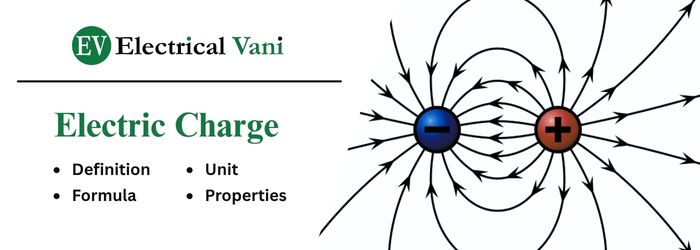Electric Charge is one of the important concepts in electrical engineering. This article is meant to explain the electric charge definition, types, unit, properties, and formula. In short, electric charge can be defined as a physical property of a material that causes it to experience forces when placed in an electromagnetic field.

Electric Charge Definition
Electric Charge is the fundamental property of subatomic particles of materials that causes it to experience attraction or repulsion forces when placed in an electromagnetic field.
In materials, electric charges are carried by electrons and protons, which are nothing but subatomic particles of matter.
Electric charge is generally represented by using symbols Q or q.
Types of Electric Charge
Electric charges can be classified into the following two types –
- Positive Charge – Positive charge (+ve charge) can be defined as the charge that experiences a repulsive force when placed in a positive electric field and experiences a force of attraction when placed in a negative electric field. Positive charge is carried by protons.
- Negative Charge – A negative charge is one that experiences a repulsive force when it is placed in a negative electric field and experiences a force of attraction when placed in a positive electric field. Negative charge is carried by electrons.
Unit of Electric Charge
The SI unit of electric charge is the Coulomb, denoted by C. The unit of electric charge Coulomb, is given to honor the research work of George Simon Ohm (Ohm’s Law).
Charge on an Electron
As we know, an electron is a negative charge carrier and it carries an electric charge of magnitude,
$$Q_e=-1.6×10^{-19}\text{ C}$$
In general, the electronic charge is denoted by “e”.
Similar to an electron, the charge carried by a proton is denoted by Qp, and it is equal to,
$$Q_p=+1.6×10^{-19}\text{ C}$$
Electric Charge Formula
Electric charge is a quantized quantity, and it is given as an integer multiple of elementary charge (e), i.e.
q = ne
Where n = 1, 2, 3, 4,…
Therefore, the number of electrons constituting 1 coulomb of charge is,
$$n=\frac{q}{e}=\frac{1}{1.6×10^{-19}}$$
$$∴n=6.24×10^{18}\text{ electrons}$$
Properties of Electric Charge
Electric charge has the following three key properties –
- Like (same) charges repel each other, i.e., negative-negative charges or positive-positive charges repel each other.
- Unlike (dissimilar) charges attract each other, i.e., negative-positive charges attract each other.
- Conservation of charge – Electric charge is a conserved quantity. Hence, charge can neither be created nor destroyed. The total charge of an isolated system remains constant.
Conclusion
Hence, this is all about electric charge and its definition, formula, unit, and properties. In conclusion, electric charge is an invisible physical characteristic of matter, but it is entirely responsible for the existence of electricity.